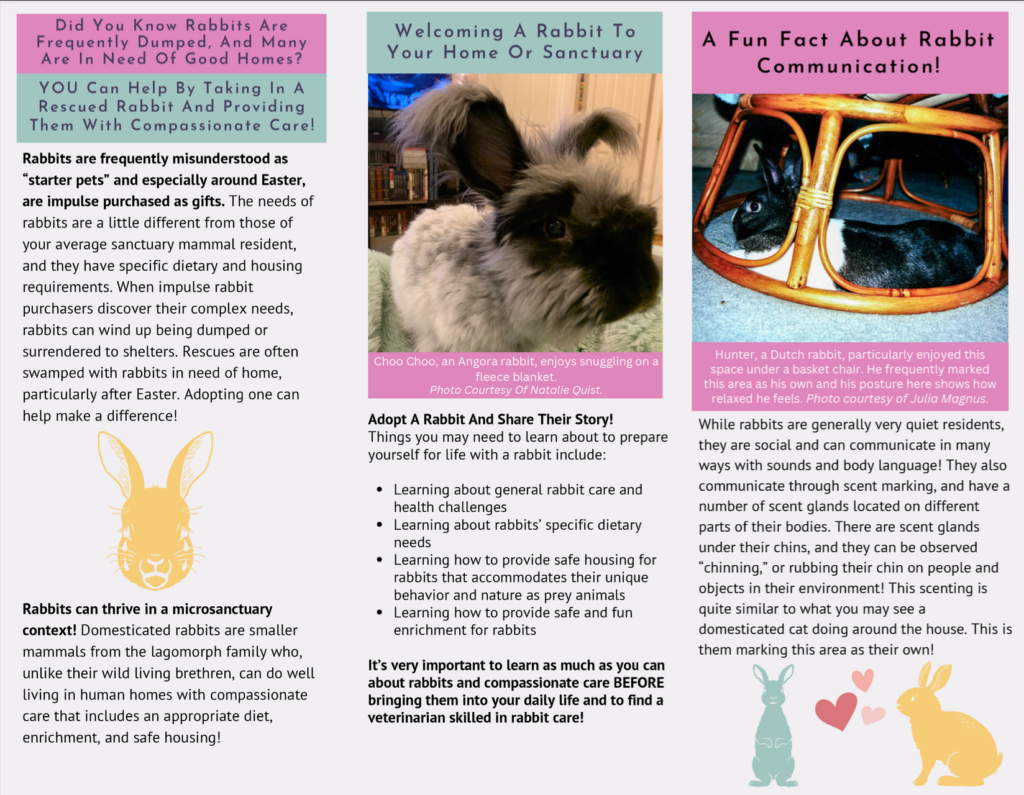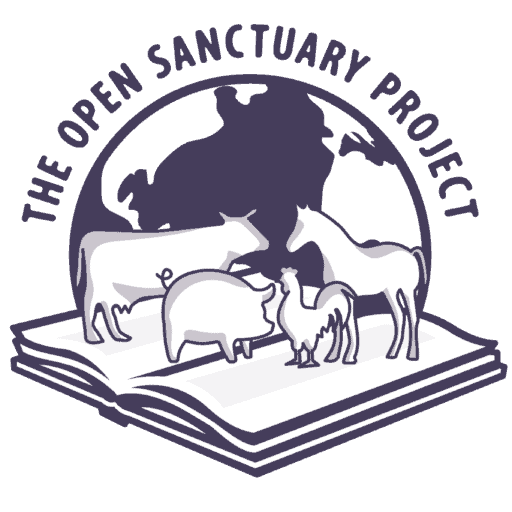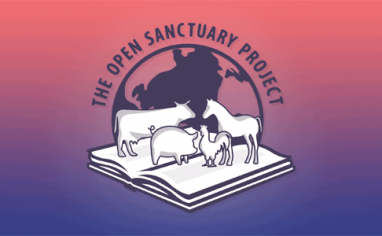

Enter either your organization’s name or your name and email below to download a free brochure PDF that you can have printed out for visitors to your organization who are interested in learning more about what it takes to provide lifelong compassionate care for rabbitsUnless explicitly mentioned, we are referring to domesticated rabbit breeds, not wild rabbits, who may have unique needs not covered by this resource.. Physical literature is a great way to relay a lot of information in a pleasing way to curious individuals.
Looking For More Info On This Subject?
For more information on what to consider when thinking about providing lifelong care for rabbits, check out our introductory resource here!
We promise not to use your email for any marketing purposes! Would you prefer to access this form in a different way? Contact us and let us know!
How’s This Literature Working For You?
Have you used this brochure at your sanctuary and want to give us your feedback on improvements? Let us know here!
Full-Text Summary Of The Brochure:
Here’s The Open Sanctuary Project’s “So You Want To Rescue A RabbitUnless explicitly mentioned, we are referring to domesticated rabbit breeds, not wild rabbits, who may have unique needs not covered by this resource.” text summary:
Panel 1: “So, You Want To Rescue A Rabbit? Learn more about what a rabbit needs from you in order to live a long, happy & healthy life with this short guide from The Open Sanctuary Project!”
Panel 2: “Did You Know Rabbits Are Frequently Dumped, And Many Are In Need Of Good Homes? YOU Can Help By Taking In A Rescued Rabbit And Providing Them With Compassionate Care! Rabbits are frequently misunderstood as “starter petsAnimals who spend regular time with humans in their home and life for companionship or human pleasure. Typically a small subset of animal species are considered to be pets by the general public.” and especially around Easter, are impulse purchased as gifts. The needs of rabbits are a little different from those of your average sanctuary mammal resident, and they have specific dietary and housing requirements. When impulse rabbit purchasers discover their complex needs, rabbits can wind up being dumped or surrendered to shelters. Rescues are often swamped with rabbits in need of home, particularly after Easter. Adopting one can help make a difference! Rabbits can thrive in a microsanctuaryA microsanctuary is a small scale community of human and nonhuman (generally “unconventional or farmed”) animal companions, who live together in a chosen shared lifestyle and in commitment to ending the oppression of all beings. Microsanctuaries adhere to the notion that no nonhuman member of the community should “serve a purpose.” Microsanctuaries can exist in any context: rural, suburban, or urban. A microsanctuary can consist of as small a community as one animal and one human caregiver. For more information on microsanctuary please refer to the Microsanctuary Resource Center. context! DomesticatedAdapted over time (as by selective breeding) from a wild or natural state to life in close association with and to the benefit of humans rabbits are smaller mammals from the lagomorph family who, unlike their wild living brethren, can do well living in human homes with compassionate care that includes an appropriate diet, enrichment, and safe housing!”
Panel 3: “Welcoming A Rabbit To Your Home Or Sanctuary: Adopt A Rabbit And Share Their Story!
Things you may need to learn about to prepare yourself for life with a rabbit include:
Learning about general rabbit care and health challenges
Learning about rabbits’ specific dietary needs
Learning how to provide safe housing for rabbits that accommodates their unique behavior and nature as prey animals
Learning how to provide safe and fun enrichment for rabbits
It’s very important to learn as much as you can about rabbits and compassionate care BEFORE bringing them into your daily life and to find a veterinarian skilled in rabbit care!”
Panel 4: “A Fun Fact About Rabbit Communication! While rabbits are generally very quiet residents, they are social and can communicate in many ways with sounds and body language! They also communicate through scent marking, and have a number of scent glands located on different parts of their bodies. There are scent glands under their chins, and they can be observed “chinning,” or rubbing their chin on people and objects in their environment! This scenting is quite similar to what you may see a domesticated cat doing around the house. This is them marking this area as their own!”
Panel 5: “Our Free Rabbit Resources To Check Out: There are many free guides dedicated to the lifelong compassionate care of rabbits at OpenSanctuary.org! Rabbit resources include:
Introductory Care For Rabbits
Daily Diet, Treats, And Supplements For Rabbits
How To Conduct A Rabbit Health CheckThe Open Sanctuary Project uses the term "health check" to describe health evaluations performed by caregivers who are not licensed veterinarians. While regular health checks are an important part of animal care, they are not meant to be a replacement for a physical exam performed by a licensed veterinarian.
Potential Rabbit Health Challenges
Creating An Enriching Life For Rabbits
How To Trim A Rabbit’s Nails
Fun Facts About Rabbits”
Panel 6: “Learn More About The Open Sanctuary Project. The Open Sanctuary Project is a freely accessible, always growing digital guide for any resources or information you need in order to responsibly create and successfully manage an animal sanctuary or to provide the best possible care to animals in order to help them live long, healthy, happy lives free of exploitationExploitation is characterized by the abuse of a position of physical, psychological, emotional, social, or economic vulnerability to obtain agreement from someone (e.g., humans and nonhuman animals) or something (e.g, land and water) that is unable to reasonably refuse an offer or demand. It is also characterized by excessive self gain at the expense of something or someone else’s labor, well-being, and/or existence.. All of our resources are researched and responsibly crafted with the intention of promoting compassionate care standards and practices for animals in need of help and sanctuary, while identifying and discouraging practices that are exploitative or harmful to the individual. Visit www.OpenSanctuary.org”








